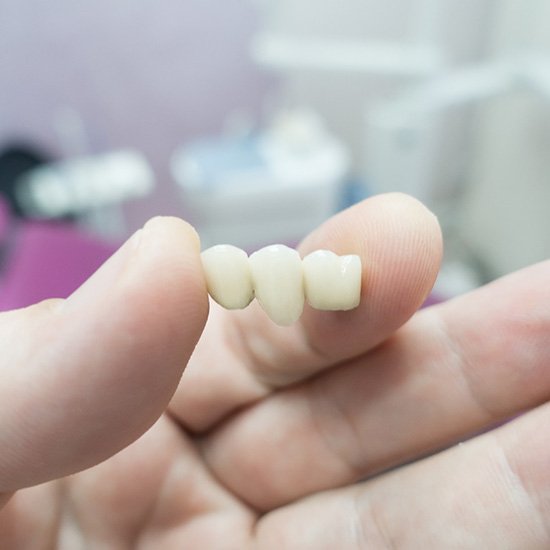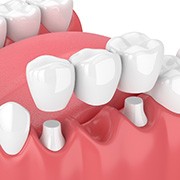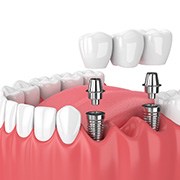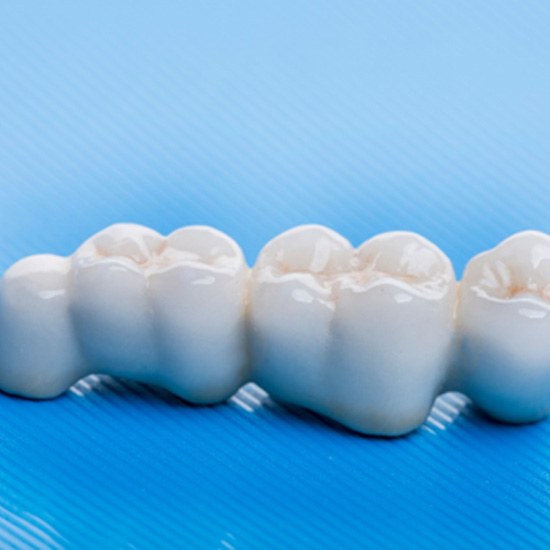Dental Bridges – Fairfax, VA
Bridge the Gap in Your Grin
No one wants to be missing a tooth, but thanks to modern restorative dentistry you always have several smile solutions. When you are missing one or a few consecutive teeth but your teeth on either side of the gap are healthy, a dental bridge definitely merits consideration. At MJM Family & Cosmetic Dentistry, count on our dentists to bridge the gap in your grin to restore its appearance and balance, plus this new addition will prevent dental drift and reduce your risk of gum disease. Contact your restorative dentist in Fairfax to schedule a consultation!

What Is a Dental Bridge?

Dental bridges are designed to help patients who are missing one tooth or several teeth in a consecutive row. An alternative to partial dentures, this tried-and-true tooth-replacement solution uses dental crowns or dental implants to secure the pontics (free-standing replacement teeth) in place. Since the materials used are available in a wide range of lifelike shades, modern dental bridges fill the gap in your smile seamlessly. Plus, they are incredibly durable, ensuring your bite doesn’t suffer either!
Types of Dental Bridges

The first step to regaining your primetime grin is a consultation with our dentist. They’ll conduct an oral examination, ask about your goals, and review your medical history. Based on their findings, one of the following treatment options will be recommended:
Traditional Dental Bridge

A traditional dental bridge can replace a single missing tooth or several teeth in a row. This restorative treatment requires you to have a natural, stable adjacent tooth in front of and behind the space that you’re wanting to fill in. Essentially, we’re “bridging the gap” by making a single unit of three or more teeth.
Implant Bridge

As the name implies, an implant bridge uses dental implants as opposed to crowns. The implants are placed on either side of the gap in your smile, and after they’ve fused with the jawbone, we’ll be able to attach the dental bridge to the implants to replace two or more missing teeth. Considered the strongest and most stable system, an implant-supported bridge requires surgery to embed the implants into the jawbone. Your time invested in this option will pay off in the quality of the result!
The Benefits of Getting a Dental Bridge

When you replace your missing teeth with a dental bridge in Fairfax, you can expect to enjoy an array of benefits including:
- Maintained alignment of your existing teeth
- Improved oral health
- Easy cleaning and maintenance
- Jawbone preservation with implant bridges
- Long-lasting results (15 years with traditional & 35+ with implant-supported)
- Natural-looking smile
Dental Bridges FAQs

So, you’re seriously considering dental bridges in Fairfax? That’s great to hear – these prosthetics will restore and beautify your smile! Still, you’d be wise to learn more about them before committing. Having the correct facts helps you feel confident about a given treatment. Fortunately, MJM Family Dentistry can help you get started: below are the answers to some popular bridge questions. Feel free to read them and grasp how our bridges work. If you need further details, though, don’t hesitate to call us.
Is Getting a Dental Bridge Painful?
You can rest at ease: getting a dental bridge isn’t painful. In fact, dentists try to make the placement process as smooth and gentle as possible.
You see, the dental team will numb your teeth before treatment. Done with a topical anesthetic, this step ensures you won’t feel discomfort from the tooth-shaping process. The dentist can also add sedation for especially nervous or anxious patients.
Granted, treated teeth may feel sensitive after standard bridge placement. The same is true for an implant bridge procedure, which involves implant surgery. In either case, though, taking over-the-counter pain relievers should help. Plus, you can call your dentist if the discomfort worsens.
How Long Should a Dental Bridge Last?
The average dental bridge lasts anywhere from five to 15 years. However, the exact lifespan of your own will depend on various factors.
Lifestyle plays an especially large role in dental bridge longevity. Oral hygiene, for example, impacts whether a bridge fails from tooth loss, gum infection, or worse. Similarly, bad habits like smoking and nail-biting can cause the appliance to stop working.
More technical matters also influence a bridge’s lifespan. One that replaces front teeth may last longer, as it won’t suffer as much wear and tear from chewing. An implant bridge usually has a longer lifespan as well, as it relies on durable implant posts.
How Many Teeth Can a Dental Bridge Replace?
Generally, a dental bridge can replace anywhere from one to four missing adjacent teeth. That said, a dentist normally uses one to replace one or two at most.
The issue is that a bridge loses stability as it extends. In other words, it’s more likely to fail as it replaces more teeth. (Even more so when the supports aren’t strong and healthy.) Therefore, having a bridge try to restore three or more teeth is a risky move.
Of course, you can reduce the risk with an implant bridge. This model relies on implants for security instead of natural teeth. Consequently, the odds of breakage would decrease.
Can Dental Bridges Be Whitened?
Sadly, no – a dental bridge can’t be whitened as natural teeth can. Its features don’t allow it to benefit from the whitening treatment.
The problem is that bridges are made of porcelain and ceramic. These materials lack the tiny pores of enamel, which allow bleaching gel to enter and break apart stains. For this reason, a whitening treatment could lead to a mismatch of whitened natural teeth and an unchanged bridge.
Thankfully, there are possible workarounds for whiteners’ conflict with dental bridges. You could receive teeth whitening before the bridge is placed. That way, your final restoration will match the ideal shade of your enamel.







